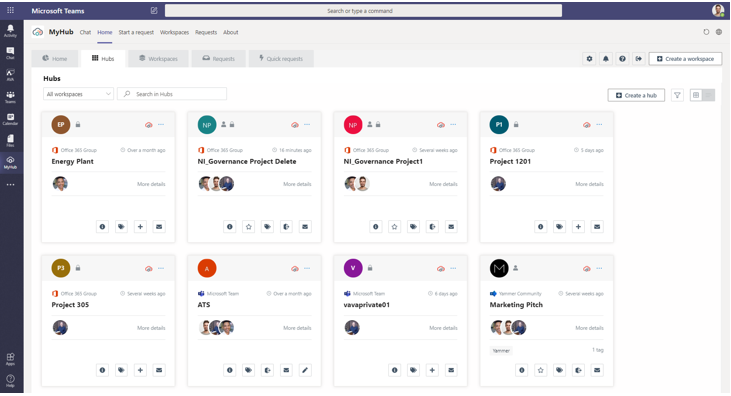Still adjusting to WFH? Watch our webinar “How To Ensure Microsoft 365 Collaboration Success For Remote Workers!“
Microsoft Teams is one of the most valuable enterprise solutions available today. That’s not hyperbole. Forrester found the three-year net present value per user was $5,416, or for a 5,000 user organization, $27.1 million.
That’s an ROI of 832% BEFORE you factor in COVID and the explosion of remote work.
However, organizations can’t just roll the ball on the court and say “have at it.” Especially when it comes to IT and support teams remote and off-site, organizations need to coach their users and draw up a few plays to maximize productivity and impact on the bottom line.

Overcoming Common Microsoft Teams Adoption Challenges and Productivity Blockers
Here are common challenges for both new and mature Microsoft Teams users along with learning resources, tips, and AvePoint solutions for solving them.
1. It’s a new way of working. Microsoft Teams utilizes concepts like persistent communication across workspaces like Teams, channels, private channels, and chats that is fundamentally different (and better) than email, Skype, and the communication tools that preceded it. We’retraining end users not just on how to use a new tool, but how to work in a new way. For example, a guest in an upcoming ShiftHappens season podcast episode spoke about how their users initially thought they had to create a Team for every meeting they wanted to hold.
- Solution To Simplify: Proactively communicate with users on basic concepts and leverage resources on what to use when, Teams etiquette, and how to hold effective meetings.
2. It’s integrated into everything and it gives a lot of power to users. Microsoft Teams can be integrated into just about anything. That makes it extremely powerful, but it can also be confusing for users who might not be as familiar about the mechanics of Office 365 Groups (there are more than 20 ways to create them), a SharePoint site, or anonymous links and how they intersect and ultimately impact what gets shared with whom.
Thiscan have negative effects on productivity, result in sensitive data leaks, and create shadow users. Additionally, Teams gives a lot of power to Owners (by default any user who creates the Team) who may not be trained in your organization’s governance processes.
And if they are, will need to make the correct choice 100% of the time during the workspace’s lifecycle. You are at the mercy of your least attentive Owner.
- Solution to Simplify: Spend time learning the most common department or agency use cases to create tailored Teams that have relevant tabs, bots, and channels. Leverage Team Cloning to get the full use of these “templates.”
- Solution to Simplify: Strongly consider removing the ability to create anonymous external links within your organization. If you have recently launched Teams, it is now shipping with the ability for users to invite external guests on by default. Guest access and entitlement governance is a separate blog for another time, but evaluate if that setting is right for your organization and how you will govern guest access over time.
- AvePoint Solution To Simplify: Give your users “bumpers” so they aren’t throwing governance gutter balls. Prevent workspace configuration drift by locking down desired settings and automating the creation of Teams in accordance with governance policies via Cloud Governance. You can even create separate policies appropriate for each department or agency and tie them into the Team “templates” being cloned.
- AvePoint Solution To Simplify: Give yourself an insurance policy. Owners can delete the Team and the data within it or mess up the permissions in the SharePoint site where the files are stored. Many organizations, such as the Milwaukee Metropolitan Sewage District (case study here), thathave data retention requirements and want to expand their use of Teams have deployed AvePoint Cloud Backup to protect against inevitable human error.
- AvePoint Solution To Simplify: Get visibility into what sensitive data is being shared with who and accessed with what frequency (even if it isn’t labeled/tagged as sensitive!) with Policies and Insights. Get a prioritized list of highest risk activity and create granular policies to automatically prevent those actions from taking place.
Looking for tips on driving productivity in Teams? Check out this post: Click To Tweet
3. It’s where everything happens. It’s the Microsoft-proclaimed “hub for teamwork” and it’s true—but the sheer amount of information can be overwhelming and difficult to sort.
For example, I am currently a member of 61 Teams and one private channel at AvePoint. That’s a lot to scroll through when I’m looking for a certain file in a particular file tab of a channel. Microsoft tries to help by hiding 37 of my less active Teams, but the file I’m looking for still might not be “above the fold.”
To make things easier on myself, I decided to curate my Teams, but it takes a lot of time to determine which Teams can stay and which can go. I need to see who is a member, how active the Team is, what it’s being used for, what files are hosted within it, and more.
And to be honest, I can’t quite bring myself to leave because of FOMO. Once I leave the Team, Murphy’s Law dictates I will immediately need to access it. The Teams interface is GREAT for finding messages, but again it takes a lot of clicking to scroll through public Teams to find the one you want to join or re-join.
I don’treally want to have less Teams. What I want is a better way to curate them. And my Yammer communities. And my Groups. And my SharePoint sites.
- AvePoint Solution To Simplify: MyHub is no longer just the Teams interface for Cloud Governance users. AvePoint just launched new standalone functionality within MyHubavailable for any userto simplify Microsoft Teams.
MyHublets you easily sort through and group (group your Groups!) workspaces to find what you need.It visualizes your workspaces in a Pinterest-esque board that allows you to quickly seethe what and why.

One click gives you access to workspace details, content, and ownership.
And my favorite part, I can now put all my workspaces across all the different Microsoft 365 services into hubs that are significant to me. For example, I can group all of my marketing workspaces together and create a different tag and group all of my event-relatedworkspaces together.
Request ademo here. You can also use it for free until the end of the calendar year with our WFHReady Kit. And if you are a Cloud Governance owner, talk to your AvePoint rep about how to get this rolled out across your organization at no additional cost.
